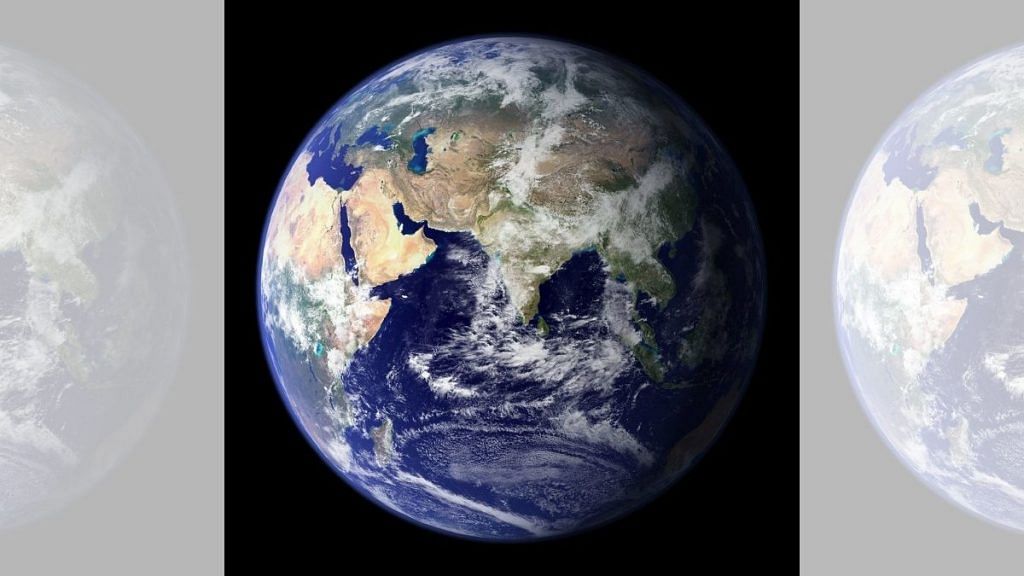New Delhi: The warming of oceans, as a result of the ongoing climate crisis, has caused a drop in the brightness of the Earth.
Using decades of measurements of earthshine — that is the light reflected from Earth that illuminates the surface of the Moon — as well as satellite measurements, researchers found a significant drop in Earth’s reflectance over the past two decades.
The Earth is now reflecting about half a watt less light per square meter than it was 20 years ago. That’s the equivalent of 0.5 per cent decrease in the Earth’s reflectance or albedo. Earth reflects about 30 per cent of the sunlight that shines on it.
The researchers noted that the dimming trend became more pronounced in the past three years.
The changes in Earth’s reflectiveness can also be an indicator of how much more solar energy is being captured by Earth’s climate system.
Once this significant additional solar energy is in Earth’s atmosphere and oceans, it may further contribute to global warming. Read more.
Also read: MIT scientists create glow-in-the-dark bionic plants that can be charged with LEDs
Early humans domesticated ‘world’s most dangerous bird’
Scientists have found evidence which shows that early humans in New Guinea domesticated cassowary, which are notorious for being able to cause fatal injuries to humans if provoked.
Cassowaries today are often labeled “the world’s most dangerous bird”. Although they mainly feed on fruits, if provoked they are capable of disemboweling a human being.
But about 18,000 years ago, humans may have collected cassowary eggs near maturity and then raised the birds to adulthood just like modern day humans raise chickens.
However, young cassowary chicks imprint readily to humans. Imprinting occurs when a newly hatched bird decides that the first thing it sees is its mother. If that first glance happens to catch sight of a human, the bird will follow the human anywhere.
For the study, researchers looked at ancient egg shell remains and used a new method to determine how old a chick embryo was when an egg was harvested. Read more.
Also read: Scientists create ‘concrete’ using blood, sweat, tears of astronauts for construction on Mars
Two new dinosaur species discovered
Scientists have discovered bones that belong to two new species of dinosaurs closely related to the giant Spinosaurus that hunted prey on both land and in the water.
The discovery of the bones was led by palaeontologists from the University of Southampton on the beach. Over several years, the team found two skulls, and a large portion of a tail.
In all, over 50 bones from the site have been uncovered from rocks that form part of the Wessex Formation, laid down over 125 million years ago during what is know as the Early Cretaceous period.
The first specimen has been named Ceratosuchops inferodios, which translates as the “horned crocodile-faced hell heron”.
With a series of low horns and bumps ornamenting the brow region the name also refers to the predator’s likely hunting style, which would be similar to that of a heron. Herons famously catch aquatic prey, but their diet can include terrestrial prey as well.
The second was named Riparovenator milnerae. This translates as “Milner’s riverbank hunter”, in honour of a British palaeontologist Angela Milner, who recently passed away. Read more.
Also read: How artificial cells could gobble up bacteria, deliver medicines
Bacteria could help boost plant growth on Martian soil
Researchers have found that a nitrogen-fixing bacteria can help enhance plant growth on Martian soil, paving the way for farming in future Martian colonies.
For the study, the researchers grew clover plants grown in Mars-like soils in the lab.
The soil on Mars lacks some essential plant nutrients, including certain nitrogen-containing molecules that plants require to live. Farming on Mars will require strategies to increase the amount of nitrogen compounds in the soil.
On Earth, bacteria in soils help convert or “fix” atmospheric nitrogen into the molecules that plants need.
The researchers grew clover in lab-made soil that closely matches that of Mars.
They added microbe Sinorhizobium meliloti, which is commonly found in clover root nodules on Earth. The researchers found that the clover experienced 75 per cent more root and shoot growth when the bacteria. Read more.
Also read: Asteroid with shortest orbital period in solar system spotted & human DNA from 7,200 years ago
New stronger glass inspired by sea shells
Scientists from McGill University have developed stronger and tougher glass, inspired by the inner layer of mollusk shells. Instead of shattering upon impact, the new material has the resiliency of plastic and could be used to improve cell phone screens in the future.
The new material is three times stronger than the normal glass, but also more than five times more fracture resistant, according to the researchers.
The scientists took the architecture of the mother of pearl or nacre and replicated it with layers of glass flakes and acrylic, yielding an exceptionally strong yet opaque material that can be produced easily and inexpensively.
They then made the composite optically transparent. Read more
(Edited by Poulomi Banerjee)
Also read: Rare fossil turtle egg discovered, belongs to species that died when asteroid wiped out dinos
